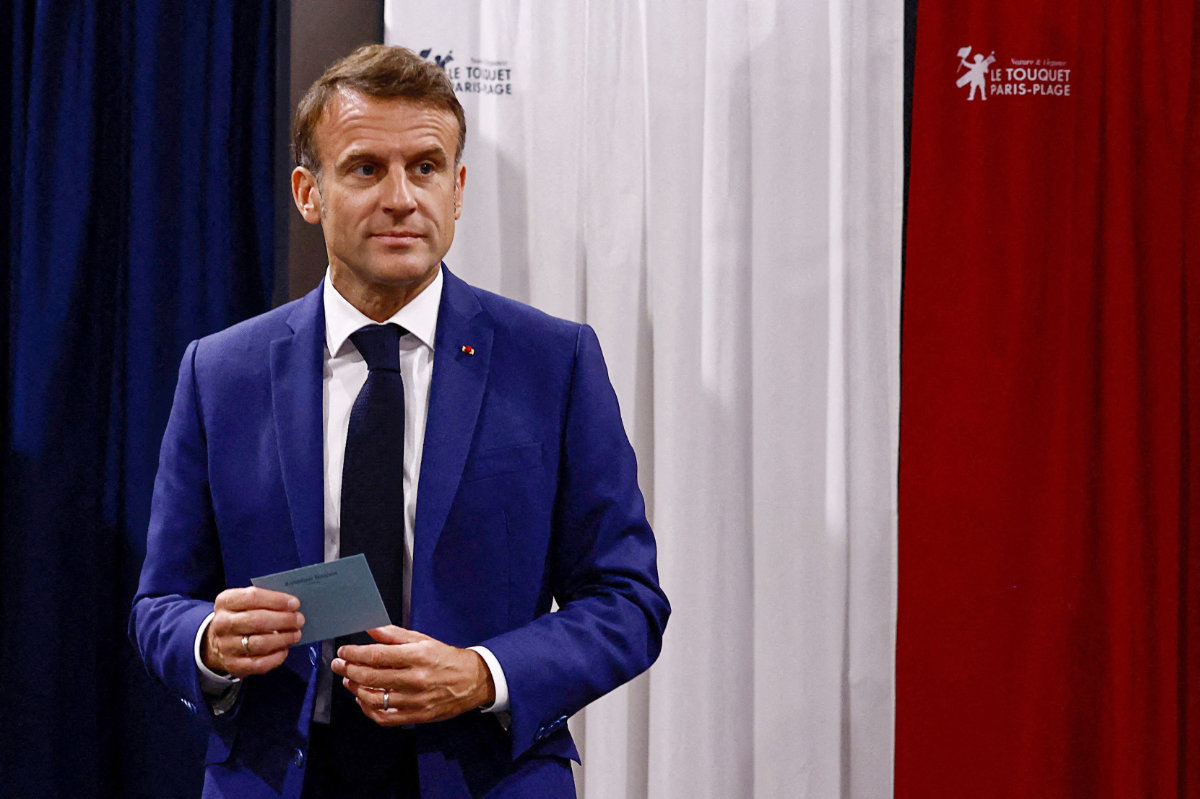PARIS: French voters face a crucial decision in the runoff of the early parliamentary elections on July 7. It could lead to the country’s first far-right government since the Nazi occupation in World War II – or it could lead to no majority at all.
Forecasts from opinion research institutes indicate that the far-right Rassemblement National has a good chance of winning a majority in the lower house for the first time. But given the complex electoral system, the outcome remains uncertain.
In the first round on Sunday, the Rassemblement National took the lead with an estimated one-third of the vote. The New Popular Front, which includes the center-left coalition, the Greens and the radical left, came in second, ahead of President Emmanuel Macron’s centrist alliance.
Here’s a closer look:
How does it work?
The French system is complex and not proportional to a party’s national support. Lawmakers are elected in constituencies.
More than 60 candidates who received at least 50 percent of the votes on Sunday were directly elected.
In addition, the two top candidates and all others who received more than 12.5 percent of registered voters qualify for the runoff election.

In many constituencies, three candidates made it to the runoff, but some tactics to block far-right candidates have already been announced: the left-wing coalition announced that it would withdraw its candidates in constituencies if they came in third place in order to support other politicians opposed to the far right. Macron’s centrist alliance also announced that some of its candidates would withdraw before the runoff to block the Rassemblement National.
This makes the outcome of the runoff election uncertain, although polls give the Rassemblement National a good chance of an absolute majority, i.e. at least 289 of the 577 seats.
The National Assembly, the lower house, is the more powerful of the two French parliamentary houses. It has the final say in the legislative process compared to the conservative-dominated Senate.
Macron has a presidential mandate until 2027 and said he will not resign before the end of his term.
What is coexistence?
If the Rassemblement National or another political force other than his centrist alliance were to gain a majority, Macron would be forced to appoint a prime minister who would belong to this new majority.
In such a situation – called “cohabitation” in France – the government would take measures that deviate from the president’s plans.
The modern French Republic has experienced three periods of cohabitation, the last from 1997 to 2002 under conservative President Jacques Chirac and Socialist Prime Minister Lionel Jospin.
The Prime Minister is accountable to Parliament, leads the Government and introduces bills.
“In the case of cohabitation, the policies of the Prime Minister will essentially be implemented,” said political historian Jean Garrigues.

The president is weakened during cohabitation at home, but still has power over foreign policy, European affairs and defense, as he is responsible for negotiating and ratifying international treaties. The president is also commander-in-chief of the country’s armed forces and the one who holds the nuclear codes.
“It is possible for the President to prevent or temporarily suspend the implementation of a certain number of the Prime Minister’s projects, as he has the power to sign or not sign the Government’s regulations and decrees,” Garrigues added.
“Nevertheless, the Prime Minister has the power to submit these ordinances and decrees to a vote in the National Assembly, thus overriding the President’s reluctance,” he noted.
Who directs defense and foreign policy?
In earlier phases of cohabitation, defence and foreign policy were considered the informal ‘reserved field’ of the president, who usually managed to find compromises with the prime minister that allowed France to speak with one voice abroad.
But today, the views of both the extreme right and the left coalition in these areas differ radically from Macron’s approach and would likely lead to tensions in the event of possible cohabitation.
According to the constitution, “the president is the head of the military, but the armed forces are at the disposal of the prime minister,” Garrigues said.
“The president’s room for maneuver is also significantly limited in the diplomatic field,” Garrigues added.

Far-right politician Jordan Bardella, who could become prime minister if his party wins a majority of seats, said he wanted to be “a cohabiting prime minister who respects the Constitution and the role of the President of the Republic, but does not compromise on the policies we implement.”
Bardella said that if he were to become prime minister, he would oppose the deployment of French troops to Ukraine – a possibility Macron has not ruled out. Bardella also said he would oppose French supplies of long-range missiles and other weapons that could hit targets in Russia itself.
What happens if there is no majority?
The president can appoint a prime minister from the group with the most seats in the National Assembly – this has also been the case with Macron’s own centrist alliance since 2022.
However, the Rassemblement National has already stated that it would reject such an option because it would mean that a far-right government could soon be overthrown by a vote of no confidence if other political parties were to join forces.
The president could try to build a broad coalition from left to right, an option that seems unlikely given the political divergences.
Prime Minister Gabriel Attal hoped on Sunday that he would succeed in winning over enough centrist MPs to work together with other “republican forces”, including possibly centre-left and centre-right forces, to develop “a majority of projects and ideas”.

Another complex option, experts say, would be the establishment of an “expert government” that would not be tied to any political party but would still need to be approved by a majority of the National Assembly. Such a government would likely deal with day-to-day affairs rather than implement major reforms.
If the political talks take too long, given the summer holidays and the Olympic Games in Paris from July 26 to August 11, a “transitional phase” cannot be ruled out, said Garrigues. During this time, Macron’s centrist government will “continue to be in charge of current affairs” until further decisions are made.
“Whatever the National Assembly will look like, it seems that the Constitution of the Fifth Republic is flexible enough to survive these complex circumstances,” Melody Mock-Gruet, a public law expert who teaches at Sciences Po Paris, said in a written statement. “The institutions are more solid than they appear, even in the face of this experimental exercise.”
“But there remains another unknown in the equation: the ability of the population to accept the situation,” wrote Mock-Gruet.

